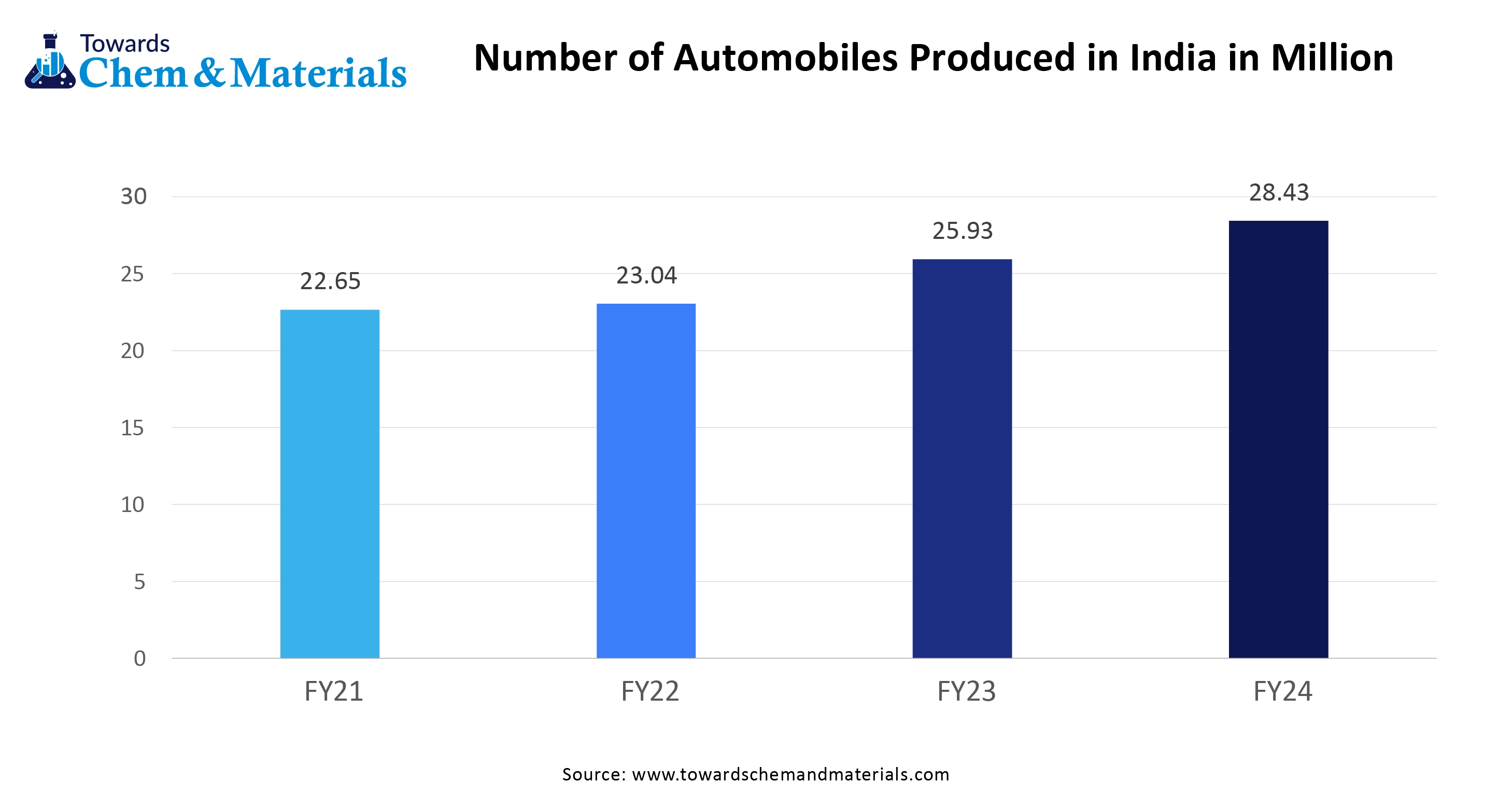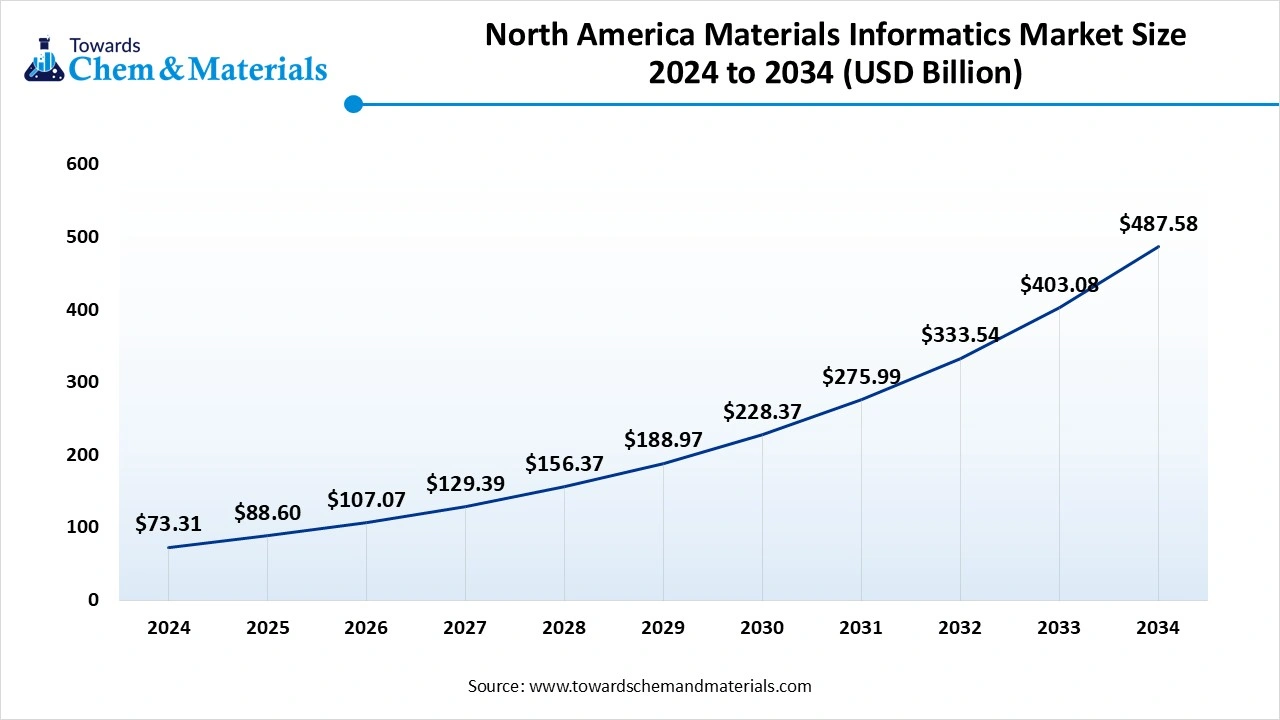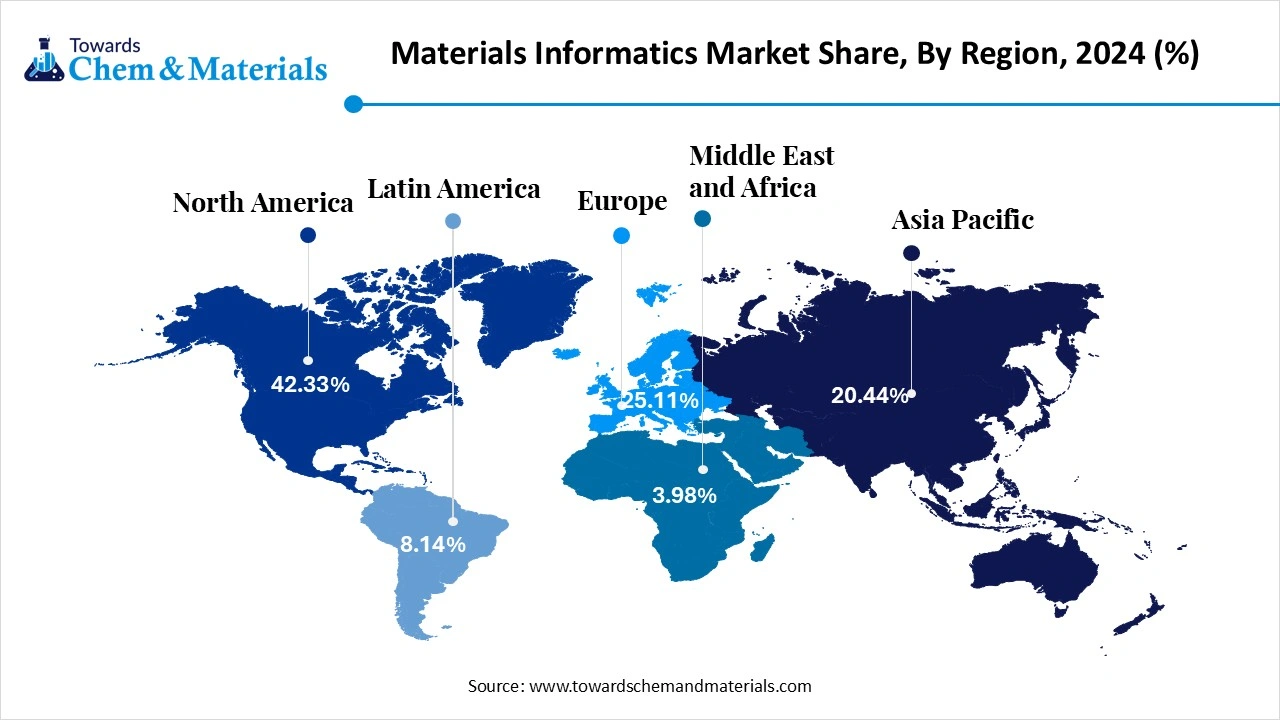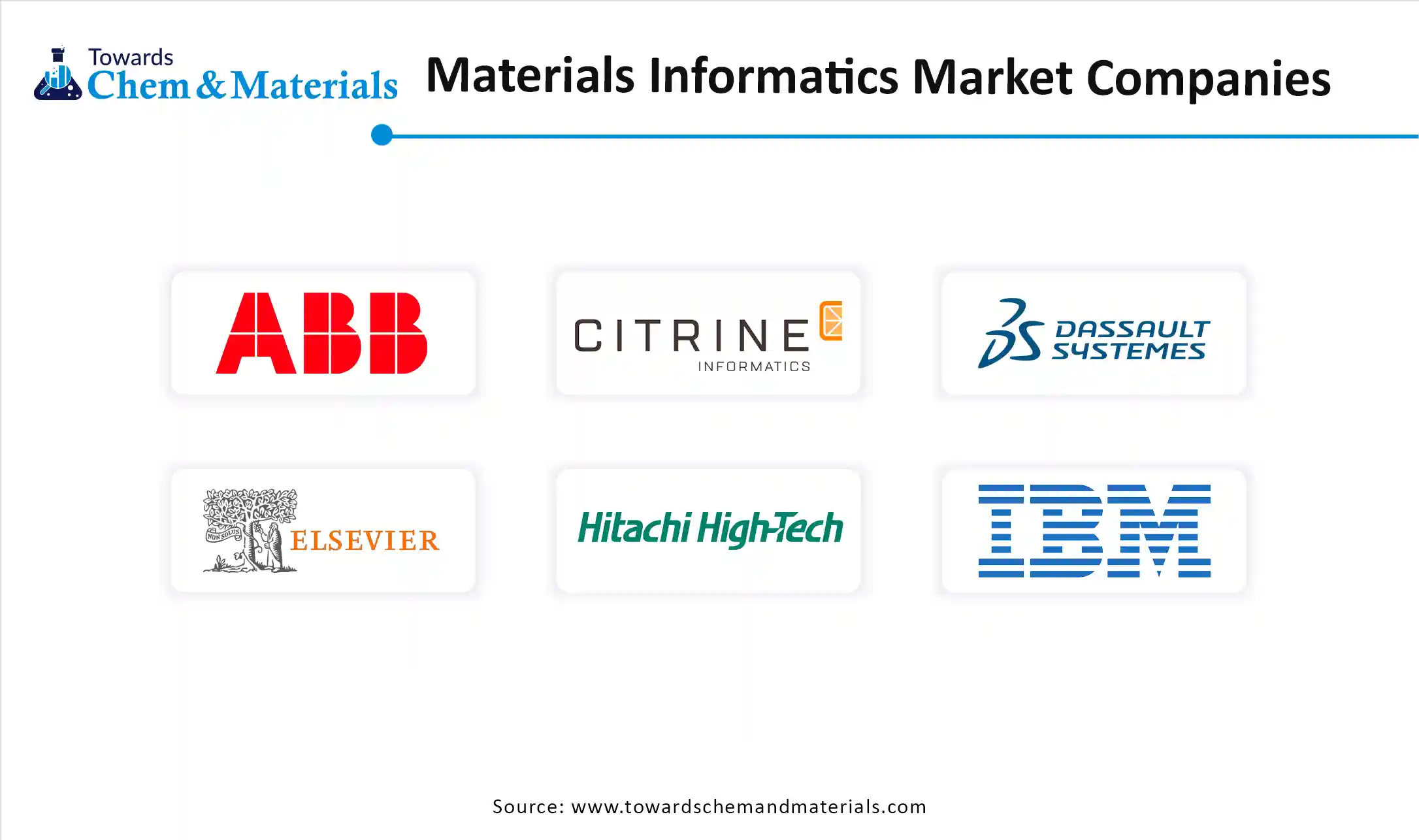September 2025
The global materials informatics market size was valued at USD 173.19 billion in 2024. The market is projected to grow from USD 209.30 billion in 2025 to USD 1,150.77 billion by 2034, exhibiting a CAGR of 20.85% during the forecast period. The growing demand for innovative materials in various industries, increasing adoption of various technologies, and growing demand for sustainable materials drive the market growth.

Materials informatics is a field of study that applies principles of data science and informatics to accelerate understanding, discovery, and development of materials. It utilizes computational tools, data, and algorithms to improve efficiency in engineering and material science. Materials informatics is made from technologies, like cloud computing, simulations, security, experiments, databases, and many more. Material informatics focuses on large datasets from existing knowledge, experiments, and simulations for material development and making predictions.
It utilizes various computational techniques like AI, statistical analysis, and machine learning. Materials informatics is widely used to design new materials by optimizing existing materials & specific properties. It helps to optimize product manufacturing and design. Materials informatics works in steps, including data acquisition, data analysis, knowledge extraction, and prediction & modelling.
The growing focus on sustainable materials increases demand for material informatics to develop eco-friendly materials. The growing integration of AI and material informatics helps in the growth of the market. Factors like growing demand for innovative materials, government initiatives for clean energy materials, the rise of ML and AI in materials development & discovery, and the growing demand from various industries like automotive, electronics, and aerospace contribute to the materials informatics market growth.
The growing expansion of the automotive industry in various regions increases demand for materials informatics for the development of automotive components. The growing demand for improving fuel efficiency and lowering vehicle weight increases the demand for advanced alloys, lightweight composites, and high-strength steels. The growing demand for vehicle safety and performance increases the demand for airbags, seat belts, and other safety systems and materials for brakes, engines, and other components. The growing focus on improving sustainability and reducing emissions in the automotive industry encourages innovation in materials informatics.
The growing adoption of electric vehicles increases demand for the motor, batteries, and other components, fueling demand for materials informatics like electrical steel and rare earth magnets. Companies like Nissan, Toyota, Citrine Informatics, Schrodinger, AI Materia, and Dassault Systèmes utilize materials informatics in the automotive industry. Furthermore, growing demand for sustainable solutions, increasing demand for advanced materials, and growing need for innovative materials to improve vehicle performance and fuel safety help in the market growth. The rapid expansion of the automotive industry is a key driver for the materials informatics market growth. (Source : ibef )

| Report Attributes | Details |
| Market Size in 2025 | USD 209.30 Billion |
| Expected Size by 2025 | USD 1,150.77 Billion |
| Growth Rate from 2025 to 2034 | CAGR 20.85% |
| Base Year of Estimation | 2024 |
| Forecast Period | 2025 - 2034 |
| High Impact Region | North America |
| Segment Covered | By Material Type, By Technology, By End Use, By Region |
| Key Companies Profiled | Dessault Systemes, ABB, Elsevier International Business Machines Corporation, Lattice Technology, Inc., Citrine Informatics, Hitachi High-Tech Corporation, Microsoft, Schrodinger Inc., Phaseshift Technologies Inc. |
The growing demand for advanced materials in various industries like electronics, aerospace, renewable energy, and automotive creates an opportunity for market growth. The growing demand for advanced materials with enhanced properties like biocompatibility, strength, durability, and conductivity helps in the market growth. The growing production of electronic devices, microprocessors, and semiconductors requires advanced materials to improve reliability and performance.
The growing healthcare industry increases demand for advanced materials for diagnostics, implants, and drug delivery systems development. The growing demand for energy increases the demand for advanced materials for the development of batteries, solar cells, and energy storage technologies. The growing adoption of sustainability utilizes advanced materials. The growing development and increasing demand for advanced materials in various industries create opportunities for the materials informatics market growth.
Despite several advantages of materials informatics in various sectors, high implementation costs limit the expansion of the market. Factors like the requirement of specialized software, infrastructure, high-performance computing, and data management expertise are responsible for the high cost. Material informatics based on diverse & vast datasets that require legacy systems, experimental results, and simulation, which are expensive.
The data comes from various sources and requires standardization, preprocessing, and harmonization, which are expensive. The requirement of specialized software and analytical capabilities for materials informatics tools increases the overall cost. The integration of material informatics with existing systems, data management, and storage increases overall cost. The high implementation cost hampers the growth of the materials informatics market.
The North America material informatics market size was valued at USD 73.31 billion in 2024 and is expected to be worth around USD 487.58 billion by 2034, growing at a compound annual growth rate (CAGR) of 20.86% over the forecast period 2025 to 2034.
North America dominated the materials informatics market in 2024. The robust technological infrastructure, including machine learning algorithms and advanced computational resources, helps in the growth of the market. The strong investment in research & development, including private sector investment & government funding, drives the market growth. The collaboration between academia and industry encourages the adoption of advanced informatics technologies, increasing demand for materials informatics.
The strong investment in chemical research increases demand for materials informatics. The growing demand from various industries like energy, electronics, aerospace, and automotive drives the market growth. Additionally, the presence of key players like Citrine Informatics, Mat3ra, AI Materia, Schrodinger, Kitware, Uncountable, and Kebotix contributes to market growth.

The United States Trends in the Materials Informatics Market
The United States is growing in the materials informatics market. The presence of machine learning and Artificial Intelligence (AI) in the region helps in the market growth. The ongoing innovation and research & development in materials science increases demand for materials informatics. The growing focus on advanced manufacturing, like 3D printing, and the adoption of sustainable materials drive the market growth. The growing demand from various industries like electronics & aerospace supports the overall growth of the market.

Rise of Materials Informatics in Asia Pacific
Asia Pacific is experiencing the fastest growth in the market during the forecast period. The well-established manufacturing sector increases demand for new & improved materials helps in the growth of the market. The growing adoption of big data analytics, AI, and machine learning enables faster material design & discovery, increasing demand for materials informatics.
The government's strong investments in research & development and innovation in materials informatics help in the market growth. The growing adoption of sustainable materials in various industries manufacturing, packaging, and construction, increases demand for materials informatics. The region is a global hub for materials informatics, and semiconductor manufacturing helps in the market growth. Furthermore, the growing expansion of industries like energy, electronics, and automotive supports the overall growth of the market.
China Trends in the Materials Informatics Market
China is a major contributor to the materials informatics market. The growing industrialization, strong manufacturing base, and focus on technological advancements help in the growth of the market. The strong investment in data analytics, AI, and machine learning, and growing research & development in these areas, drives the market growth. The growing development of new materials like bio-based materials, battery materials, and nanomaterials increases demand for materials informatics. The growing expansion of the manufacturing industry in areas like energy and electronics contributes to the overall growth of the market.
India Trends in the Materials Informatics Market
India is significantly growing in the materials informatics market. The government support and initiatives like Make in India encourage the adoption and development of advanced materials and focus on innovation, driving the market growth. The growing technological advancements in the region in big data analytics, artificial intelligence, and machine learning help in the market growth. The growing expansion of end-user industries like aerospace, electronics, pharmaceuticals, and automotive drives the overall growth of the market.
The elements segment dominated the materials informatics market in 2024. The growing demand from various industries like energy, electronics, manufacturing, and aerospace helps in the market growth. The growing demand for rare earth elements & transition metals from high-performance technologies drives the market growth. Researchers focus on utilizing databases and advanced analytical tools to study about elemental materials. Elements help to understand materials' behaviour and specific characteristics of all matter. The growing demand for advanced materials like energy storage, food science, & materials science, and the innovation of materials contribute to the market growth.
The chemicals segment is expected to grow at the fastest rate in the market during the forecast period. The growing complexity in formulations and applications in industries like pharmaceutical and chemical helps in the growth of the market. The growing advancements in computational chemistry help in the development of new materials, increasing demand for chemical materials informatics. The growing demand for new materials and chemicals drives the growth of the market. The growing demand to meet industry and consumer needs increases the demand for chemicals. Additionally, growing focus on environmentally friendly and sustainable solutions increases demand for new materials, fueling the growth of the market.
The machine learning segment held the largest share of the materials informatics market in 2024. The growing demand for extracting valuable information, analysing massive data, and identifying patterns helps in the market growth. The growing demand for predictive modelling, like predicting behaviour and materials properties under various conditions to reduce the need for physical testing, drives market growth. The growing demand for the identification of new materials with specific characteristics increases the demand for machine learning algorithms. The versatility of machine learning in various industries like pharmaceuticals, automotive, and electronics, and the ongoing advancements in machine learning algorithms contribute to the overall growth of the market.
The statistical analysis segment is growing at the fastest rate in the market during the forecast period. The growing demand for understanding materials properties and performance through identifying correlations, patterns, and trends of large datasets increases the demand for statistical analysis that helps in the market growth. The growing demand to analyze and handle complex datasets generated in materials informatics increases the demand for statistical analysis. The growing demand for decision-making in material selection, design, and optimization requires statistical analysis. The growing demand for the development of better materials, like drug formulation, batteries, and fuel cells, supports the overall growth of the market.
The chemical and pharmaceutical segment dominated the materials informatics market in 2024. The growing demand for drug discovery for tasks like predicting drug behaviour in the body, identifying potential drug candidates, and optimizing structure & properties helps in the market growth. The growing demand for optimizing and designing formulations in the chemical industry increases the demand for materials informatics. The chemical & pharmaceutical industry's extensive investment in the research & development sector drives the market growth. The growing demand for new compound development to lower environmental impact, enhance property, and improve performance increases demand for materials informatics. The growing complexity of research to accelerate drug discovery, design new compounds, and optimize formulations supports the overall growth of the market.
The electronics and semiconductor segment is experiencing the fastest growth in the market during the forecast period. The growing demand for materials with specific mechanical, electrical, and thermal properties in electronics and semiconductor industries helps in the market growth. The growing miniaturization and increasing complexity of electronic devices increase demand for materials informatics to meet specific demands. The growth in the development of materials with improved durability, conductivity, and strength increases demand for materials informatics. The growing complexity and innovation in electronic devices drive the market growth. The growing focus on green technologies and sustainable materials in the electronics industry contributes to the overall market growth.

By Material Type
By Technology
By End Use
By Region
September 2025
September 2025
September 2025
September 2025